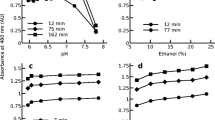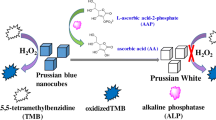Abstract
The titled compounds were examined as PPO inhibitors and antibrowning agents; their various mechanisms were investigated and discussed. All compounds reduced significantly both the browning process and PPO activity. Browning index gave strong correlation with PPO activity (r2 = 0.96, n = 19) indicating that the browning process is mainly enzymatic. Ascorbic acid could reduce the formed quinone instantly to the original substrate (catechol) at high concentration (>1.5 %) while at lower concentrations acted as competitive inhibitor (KI = 0.256 ± 0.067 mM). Cysteine, at higher concentrations (≥1.0 %), reacted with the resulted quinone to give a colorless products while at the low concentrations, cysteine worked as competitive inhibitor (KI = 1.113 ± 0.176 mM). Citric acid acted only as PPO non-competitive inhibitor with KI = 2.074 ± 0.363 mM. The products of PPO-catechole-cysteine reaction could be separation and identification by LC-ESI-MS. Results indicated that the product of the enzymatic oxidation of catechol, quinone, undergoes two successive nucleophilic attacks by cysteine thiol group. Cysteine was condensed with the resulted mono and dithiocatechols to form peptide side chains.







Similar content being viewed by others
References
Ali HM, Abo-Shady A, Sharaf Eldeen HA, Soror HA, Shousha WG, Abdel-Barry OA, Saleh AM (2013) Structural features, kinetics and SAR study of radical scavenging and antioxidant activities of phenolic and anilinic compounds. Chem Cent J 7:53–61
Altunkaya A, Gökmen V (2008) Effect of various inhibitors on enzymatic browning, antioxidant activity and total phenol content of fresh lettuce (Lactuca sativa). Food Chem 107:1173–1179
Amorati R, Pedulli GF, Valgimigli L (2011) Kinetic and thermodynamic aspects of the chain-breaking antioxidant activity of ascorbic acid derivatives in non-aqueous media. Org Biomol Chem 9:3792–3800
Chang T-S (2009) An updated review of tyrosinase inhibitors. Int J Mol Sci 10:2440–2475
Chen Q-X, Song K-K, Qiu L, Liu X-D, Huang H, Guo H-Y (2005) Inhibitory effects on mushroom tyrosinase by p-alkoxybenzoic acids. Food Chem 91:269–274
Cilliers JJL, Singleton VL (1990) Caffeic acid autooxidation and the effects of thiols. J Agric Food Chem 38:1789–1796
Constabel CP, Barbehenn R (2008) defensive roles of polyphenol oxidase in plants. In: Schaller A (ed) Induced plant resistance to herbivory. Springer Science + Business Media BV, pp 253–269
Diedrich JK, Julian RR (2010) Site-selective fragmentation of peptides and proteins at quinone-modified cysteine residues investigated by ESI-MS. Anal Chem 82:4006–4014
Dincer B, Colak A, Aydin N, Kadioglu A, Güner S (2002) Characterization of polyphenoloxidase from medlar fruits (Mespilusgermanica L., Rosaceae). Food Chem 77:1–7
Ding C-K, Chachin K, Ueda Y, Wang CY (2002) Inhibition of loquat enzymatic browning by sulfhydryl compounds. Food Chem 76:213–218
Dixon M (1953) The determination of enzymeinhibition constants. Biochem J 55:170–171
Dogăn M, Aslan O, Dogăn S (2002) Substrate specificity, heat inactivation and inhibition of polyphenol oxidase from different aubergine cultivars. Int J Food Sci Technol 37:415–423
Friedman M, Bautista FF (1995) Inhibition of polyphenol oxidase by thiol in the absence and presence of potato tissue suspensions. J Agric Food Chem 43:69–76
Garcia-Molina F, Penalver MJ, Rodriguez-Lopez JN, Garcia-Canovas F, Tudela J (2005) Enzymatic method with polyphenol oxidase for the determination of cysteine and N-acetylcysteine. J Agric Food Chem 53:6183–6189
Girelli AM, Mattei E, Messina A, Tarola AM (2004) Inhibition of polyphenol oxidases activity by various dipeptides. J Agric Food Chem 52:2714–2745
Golan-Goldhirsh A, Osuga DT, Chen AO, Whitker JR (1992) Effect of ascorbic acid and copper on proteins. In: O´Souza VT, Feder J (eds) The bioorganic chemistry of enzymatic catalysis. CRC Press, Boca Raton, pp 61–76
Kumar D, Mishra DS, Chakraborty B, Kumar P (2011) Pericarp browning and quality management of litchi fruit by antioxidants and salicylic acid during ambient storage. J Food Sci Technol. doi:10.1007/s13197-011-0384-2
Limbo S, Piergiovanni L (2006) Shelf life of minimally processed potatoes part 1. Effects of high oxygen partial pressures in combination with ascorbic and citric acids on enzymatic browning. Postharvest Biol Technol 39:254–264
Lineweaver H, Burk D (1934) The determination of enzyme dissociation constants. J Am Chem Soc 56:658–666
Misnawi JS, Jamilah B, Nazamid S (2003) Effects of incubation and polyphenol oxidase enrichment on colour, fermentation index, procyanidins and astringency of unfermented and partly fermented cocoa beans. J Food Sci Technol 38:285–295
Neves VA, Picchi DG, da Silva MA (2009) Some biochemical properties of polyphenoloxidase from spearmint (Menthaarvensis). Braz Arch Biol Technol 52:1001–1010
Nicolas JJ, Richard-Forget FC, Goupy PM, Amiot MJ, Aubert SY (1994) Enzymatic browning reactions in apple and products. Crit Rev Food Sci Nutr 34:109–157
Oliphant T, Mitra A, Wilkinson M (2012) Contact allergy to sodium sulfite and its relationship to sodium metabisulfite. Contact Dermatitis 66:128–130
Palou E, López-Malo A, Barbosa-Cánovas GV, Welti-Chanes J, Swanson BG (1999) Polyphenoloxidase activity and color of blanched and high hydrostatic pressure treated banana puree. J Food Sci 64:42–45
Peñalver MJ, Rodríguez-López JN, García-Molina F, García-Cánovas F, Tudela J (2002) Method for the determination of molar absorptivities of thiol adducts formed from diphenolic substrates of polyphenol oxidase. Anal Biochem 309:180–185
Queiroz C, Lopes MM, Fialho E, Valente-Mesquita VL (2008) Polyphenol oxidase: characteristics and mechanisms of browning control. Food Rev Int 24:361–375
Richard-Forget FC, Goupy PM, Nicolas JJ (1992) Cysteine as an inhibitor of enzymatic browning. 2. kinetic studies. J Agric Food Chem 40:2108–2113
Rupasinghe HPV, Murr DP, DeEll JR, Odumeru J (2005) Influence of 1-methylcyclopropene and NatureSeal on the quality of fresh-cut “Empire” and “Crispin” apples. J Food Qual 28:289–307
Sedaghat N, Zahedi Y (2012) Application of edible coating and acidic washing for extending the storage life of mushrooms (Agaricus bisporus). Food Sci Technol Int 18:523–530
Son SM, Moon KD, Lee CY (2001) Inhibitory effects of various antibrowning agents on apple slices. Food Chem 73:23–30
Stohs SJ, Miller MJS (2014) A case study involving allergic reactions to sulfur-containing compounds including, sulfite, taurine, acesulfame potassium and sulfonamides. ChemToxicol 63:240–243
Toivonen PMA, Brummell DA (2008) Biochemical bases of appearance and texture changes in fresh-cut fruit and vegetables. Postharvest Biol Technol 48:1–14
Watkins CB (2008) Overview of 1-methylcyclopropene trials and uses for edible horticultural crops. HortSci 43:86–94
Whitaker JR (1994) Principals of enzymology for the food science, 2nd edn. Marcel Dekker, New York
Author information
Authors and Affiliations
Corresponding author
Rights and permissions
About this article
Cite this article
Ali, H.M., El-Gizawy, A.M., El-Bassiouny, R.E.I. et al. Browning inhibition mechanisms by cysteine, ascorbic acid and citric acid, and identifying PPO-catechol-cysteine reaction products. J Food Sci Technol 52, 3651–3659 (2015). https://doi.org/10.1007/s13197-014-1437-0
Revised:
Accepted:
Published:
Issue Date:
DOI: https://doi.org/10.1007/s13197-014-1437-0




